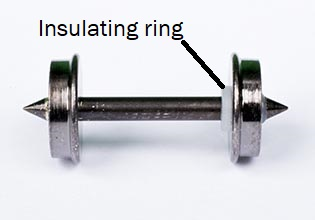(You can find Part II of this post here)
Locomotive Power
The prospect of having a dynamic railroad brings us to the last - and arguably, most exciting part of the series! Imagine beautiful little locomotives and coaches moving all over your house - some even complete with lights, sounds and smoke!
The most natural thing to use to power a locomotive would be batteries of course. But given the size of the locomotives (e.g. The Pink Engine locomotives are around 3 cm wide on average), this becomes an extremely challenging task. Remember that apart from batteries, the locomotive needs to house motors and gearing mechanisms to drive the locomotive.
An ingenious solution is to draw power from the tracks!

Tracks, Wheels and Bogies
The basic structure of HO track is shown in the graphic above. The metal rails are separated by insulated sleepers. This implies that the two rails are electrically insulated from each other. And if you didn't know already you will never guess how the power is taken from the tracks by the locomotive! (Or maybe, you will...)
The metal wheels are responsible for taking power from the two rails of the tracks and sending them to the motor and other electrical accessories aboard the locomotive!
Of course, you would have guessed by now that the metal wheels need to be electrically insulated from each other and the good thing is that they usually are! Furthermore, conductive electrical wires called pickups take power from the wheels and send them to the motors etc.
Note that pickups come in various shapes and sizes and this is just one of them...
One more thing that is important to note is that the word bogie DOES NOT refer to a coach. If you ask a train engineer or a model railroader he/she will assume that you are talking about the rotating assembly beneath a coach or wagon which holds the wheels. That's what is shown in the picture above and to the right. Be careful about this terminology.
Electrical Control
The setup till now is indicated in the graphic below. All that is required now is a power supply and controller to supply electricity to the rails and to control the speed of the locomotive.

The Pink Engine locomotives run off 12V. The wall supply takes 220 volts AC and converts it into 12 volts DC. This moves through the DC controller which can further vary the voltage via a knob, between 0V and 12V - which in turn controls the speed of the locomotive from zero to full speed respectively. The DC controller also includes a directional switch because locomotives locomotives can go in either direction (Duh!) Power is fed from the DC controller to the tracks by a special track known as the terminal track.
And there you have it. A locomotive that you can control and which will bring you endless hours of joy! There is something absolutely mesmerising about watching those things go around a track. Here is one to get you started. If you want a complete trainset, you might want to look here.
Welcome to a new definition of rail-fanning...
This concludes our introductory series




Comments